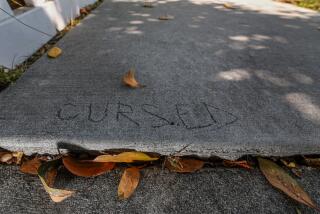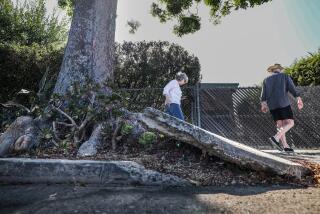L.A.’s skid row property rights
- Share via
City Atty. Carmen Trutanich is a man of his word. OK, perhaps not when it comes to his campaign promise to serve out his full term, but certainly when it involves the city’s homeless policies.
Last June, his office vowed to appeal a preliminary injunction by a federal court that temporarily barred the city’s Bureau of Street Services and police from seizing or destroying the unattended property of homeless people in downtown’s skid row neighborhood. This month, he followed through, asking the U.S. 9th Circuit Court of Appeals to overturn the injunction on the grounds that the city’s homeless are in effect using the sidewalks as “their own public storage area.”
Trutanich’s legal crusade is a misguided use of resources. The city has been sued three times since 1989 over similar seizure policies on skid row. Each time a state or federal judge has blocked the city from enforcing those policies. What is most absurd about the current standoff is that no one disputes that city officials have a right to keep the streets clean and clear. Nor do advocates for the homeless deny that police and sanitation workers have the authority to confiscate items on the streets that pose a danger to public safety or health.
The only question is how to balance the city’s interest in keeping streets safe and clean with the U.S. Constitution’s protection against unreasonable seizures of property. The homeless often carry the things they own with them but sometimes must leave them briefly unattended while eating, bathing or meeting with social workers. That shouldn’t give the police license, however, to seize and destroy those belongings, which could include identification, medication and other important personal effects. That’s why Trutanich should stop fighting the injunction and negotiate a compromise with people who have no other place to store their possessions.
Los Angeles has long held the dubious distinction of being the nation’s homeless capital. More than 23,000 people live on the city’s streets, according to a 2011 county report. With too few shelter beds and services, many of those men, women and children are stuck in the 50-block area just east of downtown that is known as skid row. They live in cars, in shelters and on the streets. Many suffer from mental and physical disabilities.
Whether the three-judge panel of the 9th Circuit will side with Trutanich remains to be seen. What is clear, however, is that the city still has time to score a victory, if only it agrees to sit down with advocates and negotiate a plan that will address the issue of unattended property once and for all.
More to Read
A cure for the common opinion
Get thought-provoking perspectives with our weekly newsletter.
You may occasionally receive promotional content from the Los Angeles Times.






